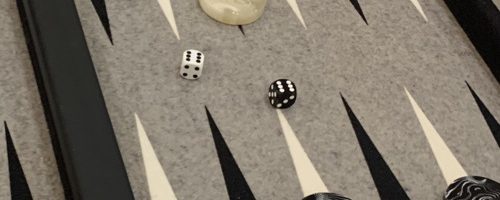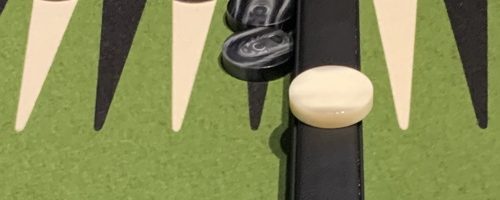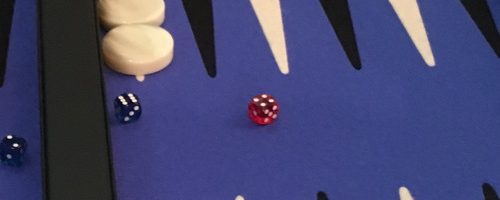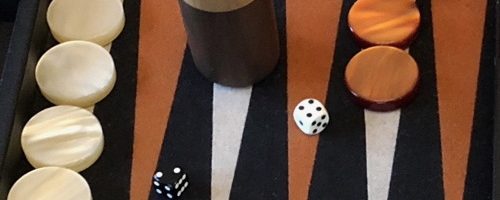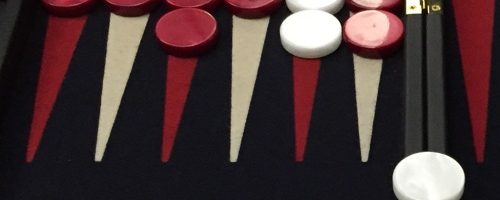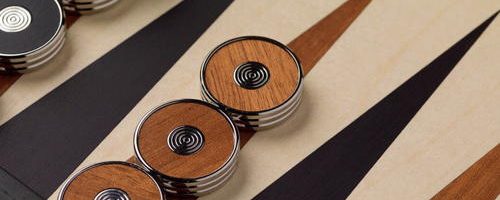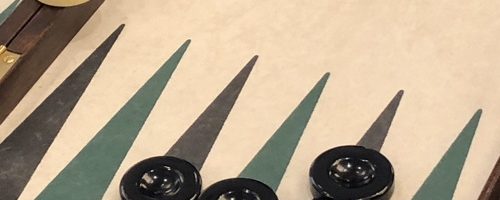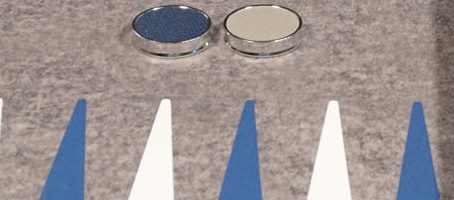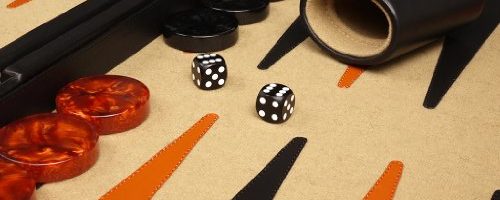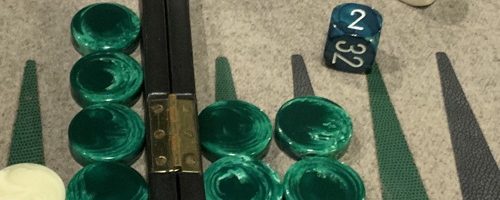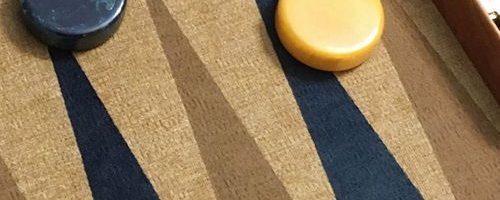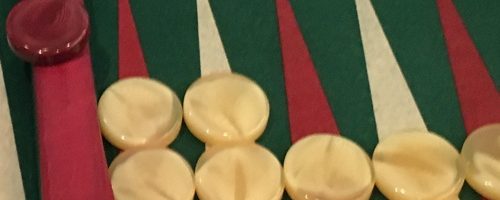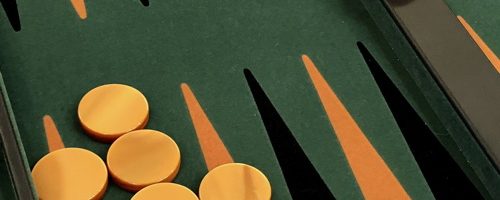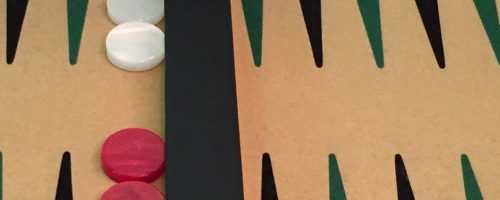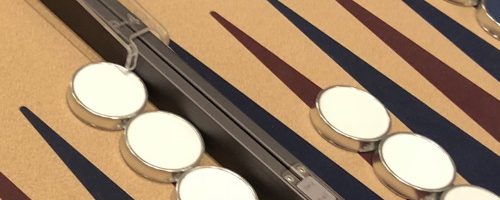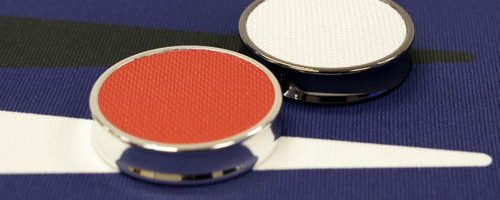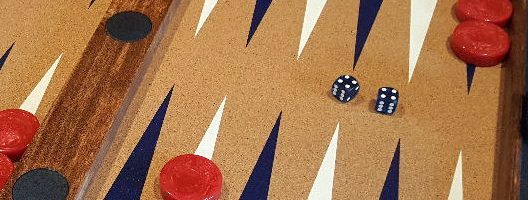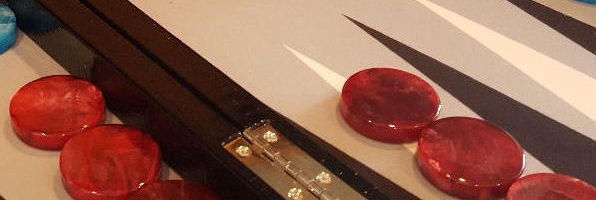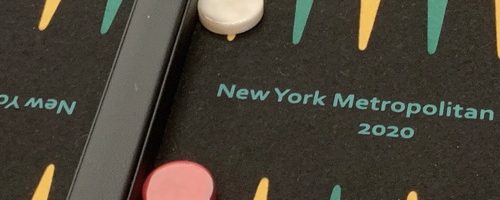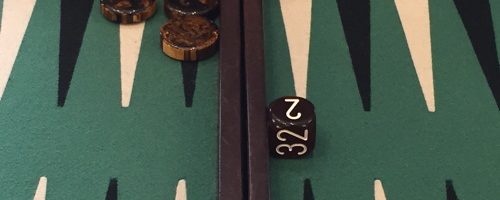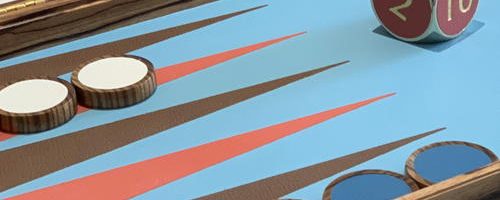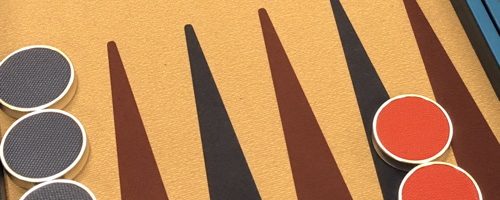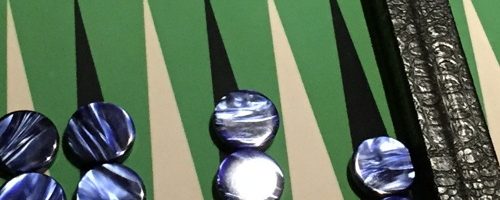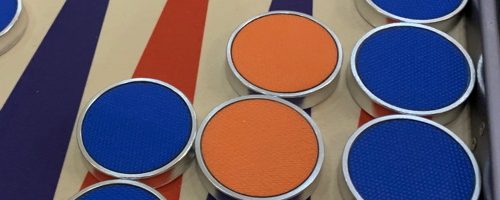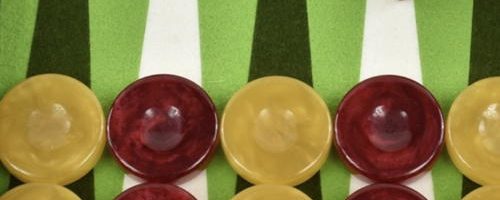General Considerations
The essentials: two sets of 15 checkers; two pair of dice; a doubling cube; and a board comprising four quadrants of six points. The variations: size, materials, colors, casing. It’s worth looking at all these details before buying — because you’ll sure be noticing them afterwards!
Checker Size & Field Proportion
The 1.75″ (4,45 cm) checker size is overwhelmingly popular in American tournament play, and is therefore generally referred to as “Tournament Size” on this side of the Atlantic. The size of the checkers will largely dictate the proportions of the playing field, and you will find that most sets with 1.75″ checkers provide a comfortable reaching distance to checkers in all corners of the board. This size also allows a player to take in the entire board position with a single gaze.
While some players love to play with big 2″ checkers, many of their opponents will find the size makes playing more difficult, both physically (straining to reach checkers) and mentally (needing to look at different parts of the board separately). However, if a maker reduces the space between opposing points in the middle of the board (see discussion below), a comfortable reach may be achieved even with these larger game pieces. Before investing in a plus-size set, you should try it out with these aspects of “playability” in mind.
Sets with smaller 1.5″ checkers are generally very comfortable, and gain some ease of portability. As checkers get even smaller, to the 1.25″ range, they become a bit more difficult to manipulate, and may get knocked around by the dice. Smaller sets are also less friendly to spectators, a vital consideration in chouettes.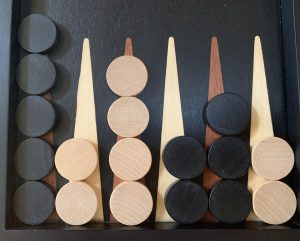
The attractive wooden set pictured here has two problems. First, the points are not quite tall enough, so just four checkers make it appear to be nearly “full.” It’s more standard for the fifth checker to nearly, or only just, cover the tip of the point. Second – and much worse – there is far too much horizontal “play” between the checkers, so they tend to slosh around on the field, requiring constant effort to keep them properly aligned. About 1/8″ of lateral play within a quadrant is all you want, so that checkers slot unambiguously onto their points.
But what about the depth of the playing field (the distance measured across the board between you and your opponent)? It turns out that there is quite a bit of variation in the ratio of width to depth among boards, resulting in a substantially different feel — so you should take notice of this aspect of rival sets before settling on one. The thing to note is how many checkers will fit in between the stacks of five checkers on your 6-points. The three examples below illustrate the range you’ll find on modern boards — anything from just under a single checker to well over two checkers’ worth of separation.


There is no “right or wrong” when it comes to board depth, but you may notice the difference in a few ways. Most important is ease of reach — the deeper the board, the farther you must reach for checkers in the far corners. There is an aesthetic difference too, as a shorter board depth yields a “wide” rectangular playing field, while a deeper board like the P-40 has a square playing field (22″ x 22″ measured inside the rails). And traditional Middle Eastern boards are usually deeper than they are wide! If you look at the boards listed farther down on this page in terms of field proportion you will notice substantial differences, and you may want to factor this subtle aspect into your selection.
Checker Styles
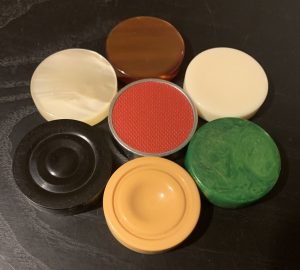
A variety of checker colors, materials, styles.
Backgammon checkers are available in a very wide range of materials, colors, styles. While the choice of checkers is mostly a matter of personal taste, there are a few practical matters to consider. First, avoid a situation where your checkers are light enough to get knocked about by the dice you will be using. Second, you may find that some checkers with “finger dips” are more liable to trap a die, leading to a frequent need to re-roll. The thickness of the checkers, the size of your dice, the depth of the checker bowl — and of course, whether you use a baffle box — will all play a part. Third, make sure the checkers store securely in the tray area, without sloshing around.
Pictured are a variety of 1.75″ checkers. The one in the center is a metal-rimmed P-40 checker, of a style made popular by Geoffrey Parker. The pearlescent sheen of the brown and white checkers are attractive, and also can help to make them stand out against similar-colored backgrounds on your playing surface. The same is true of carved surfaces as you see on the black checker. The yellow checker features a “finger dip” that can make the checker easier to grasp, but may also trap a die, requiring a re-roll. The black, yellow, and green checkers are varieties of bakelite, a vintage material, while the top three are more modern plastics.
Board Surfaces
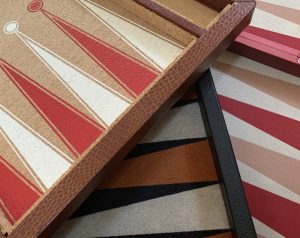
Wood, wool, synthetic surfaces.
Several issues arise over the choice of board surface, dice bounce chief among them. It is vital that the dice tumble, not skid, atop the surface. For this reason, wooden surfaces are out of favor in competitive backgammon. Another issue can be that on some harder surfaces (wood, cork, some others) a die is more likely to spin like a top for a tedious length of time. If you are trying out a board, be sure to check how the dice engage the surface. Other concerns are whether surfaces will wear well over 100’s or 1000’s of games, and whether surface marks or spills can be effectively cleaned. There are a great many surfaces to consider these days.
Wood — As mentioned, not favored in competitive circles because dice tend to skid. Can also be a little noisy. An exception is the traditional Middle Eastern boards, for which 1/4″ dice are standard. Tossed with a backhanded flip, these tiny dice get plenty of action, with a quiet clicking sound.
Cork — for decades the standard surface, and still perhaps the most sensible. It’s inexpensive, stain-resistant, easy to clean, and provides enough traction for dice to get a decent bite; but they do wear out with frequent use. Once that happens, you can get in touch with Crisloid for a re-surfacing — though it may be more economical to just buy a new set.
Leather — While leather offers associations of elegance, flat leather surfaces sometimes make for poor checker-sliding so you have to pick up the checkers, which is tedious. Some high-end leather sets like Geoffrey Parkers have a kind of pebble-textured leather that work great with their metal-rimmed checkers. So if you’re considering a leather set, make sure you like the way the checkers move across the surface before buying.
Wool — Sets with a dense carpet of wool or other fiber tend to provide an ideal dice-tumble, and checkers glide over them with ease. They also tend to be very long-wearing.
Synthetic — Modern set-makers are experimenting with a wide variety of synthetic surfaces that are difficult to characterize. Often there is a fine top-layer with the points silkscreened on the field, and a layer of foamy material underneath to provide good dice action.
With any playing surface, you should also note whether the points are painted onto the field material, inlaid with precision cutting, or applied onto the surface with stitching or glue. If painted, try to find out how quickly the points will wear away, fade, or smudge onto the background field. If inlaid, pay close attention to the precision of cutting — are there gaps? If applied to the surface, check whether sliding checkers get caught on the edges of points.
Dice Cups
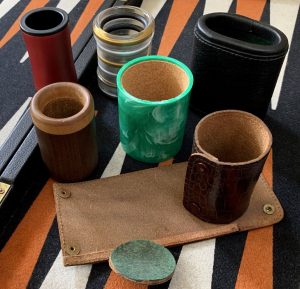
A variety of dice cups. Note that two of them are not “lipped.”
Dice cups are a crucial feature of any backgammon set, and it’s worth factoring them into your decision since they have a great deal to do with the literal “feel” of your set — on every single turn. Does the cup feel comfortable in your hand? Does it make an annoying sound when you rattle the dice? When you roll out the dice, do they tumble naturally from the cup onto the playing surface — or does a die sometimes get caught on the lip, requiring a re-roll or a hunt under the table? Are the cups large enough to accommodate the dice you like to use?
The lip is important, though: a quality lipped dice cup makes it harder for “dice mechanics” to cheat by sliding the dice smoothly out of the cup. Lipped cups are officially “preferred” in most tournaments, so your opponent may insist you put your cups aside if they do not have this edge for tripping the dice.
Also worth considering is how the cups are to be carried. Most high-end sets have cup compartments, which makes the case larger. Others have flattened cups that simply lie on the playing surface, saving space. An old tradition was the roll-up cup, which allowed boards to be very shallow. Unfortunately, the leather tended to dry up over time and the circular bottoms would break off and get lost. It would be interesting to see a modern maker craft a roll-up cup with a modern lip!
Dice & Doubling Cubes
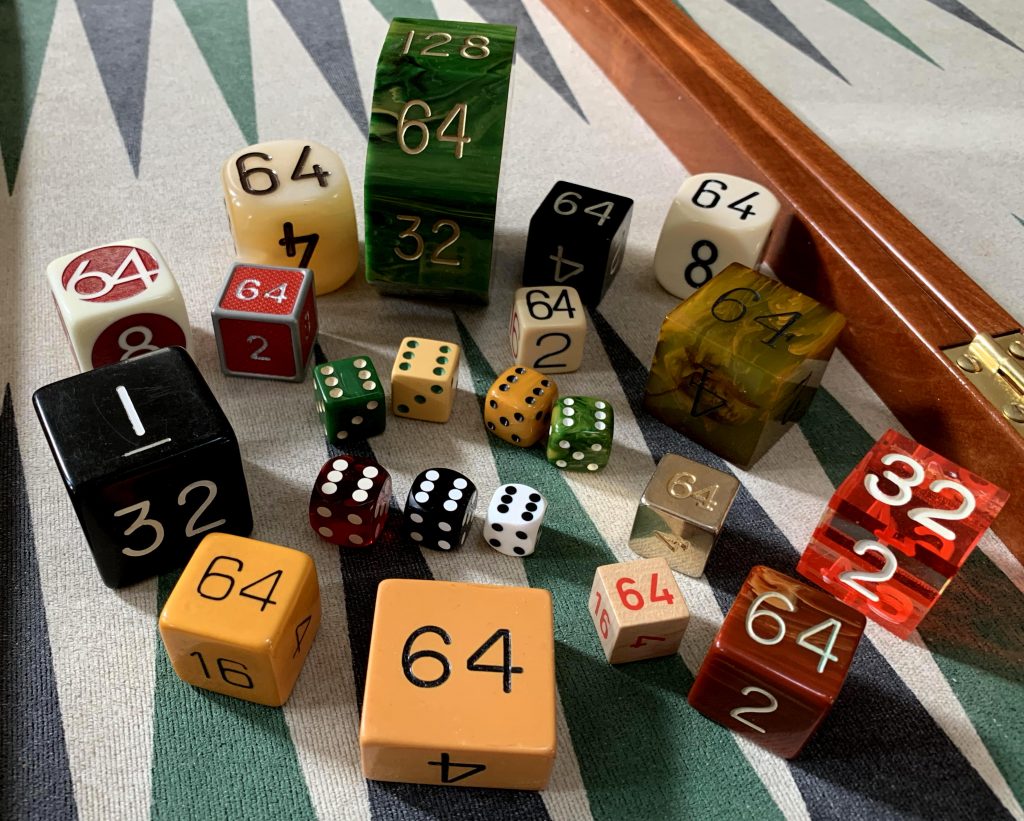
A variety of dice and cubes, including precision dice in three sizes and pitted dice with squared and rounded corners.
Backgammon sets will generally come with 4 dice and 1 doubling cube. More expensive sets should come with “precision dice,” while more modest sets will come with traditional “pitted” dice. While any physical object will never be perfectly formed, pitted dice are manifestly imbalanced, with each face having a different amount of material gouged out. A die with differently weighted sides will not deliver equal 1/6 chances for each side turning up. And because backgammon strategies rely heavily on probabilities, precision dice are strongly preferred in competition.
Unlike casino dice, which have sharp corners designed to make the dice bite and bounce on a long table, modern backgammon dice have rounded corners, so that they tumble more readily on a relatively small field of play.
The 9/16″ die size is probably most popular, but some people prefer larger 5/8″ or smaller 1/2″ ones. Whatever you choose, make sure (a) they have ample room to bounce around in your cups and don’t compete with each other trying to get out, (b) they get plenty of tumbling action on your playing surface, and (c) you can read them easily. Many players prefer opaque dice because translucent ones are easy to misread when pips from one side shine through to the surface. Others prefer translucent ones for fear of opaque ones hiding weights or magnets in their interiors (rare, but it happens).
Doubling cubes are fun. They come in all sort of sizes, materials and colors. From time to time someone tries a clever variation on the trusty cube shape, but it’s hard to beat the unambiguous solidity of thumping a cube down on the field. And as literal scoring markers, it’s important that they resist accidental bumping onto different numbers.
Compartments & Casing

Four boards with varying storage configurations.
Finally, there’s the question of how all this equipment packs up and folds together. In the image you see here we have a full range of options, from a small set where all game pieces are simply stowed in the playing surface to one where the checkers fit into a tray but cups and chouette cubes rest on the playing field, to two options where all pieces are compartmentalized, but in different orientations.
The outer dimensions of cases depend only partly on checker size. Compartments add bulk, but thoughtful makers arrive at solutions that make efficient use of space while achieving a pleasant balance of proportions and, of course, maintaining proper playing field dimensions.
Most traveling players also use a carrying case for more expensive boards, partly for convenience and partly to protect the board from hard knocks and scuffs in overhead compartments of airplanes.
Color Schemes
With many board makers inviting buyers to pick any colors they wish, the choice of color scheme can be almost overwhelming. You have 5 color decisions to make: 2 checker colors, 2 point colors, and one field color (and maybe a frame choice too). One good approach is to make deliberate choices about how many vivid “accent” colors (red, blue, green) you wish to deploy, and how best to coordinate them with supporting “neutral” tones (black, white, tan, cream). There’s no disputing taste, so there’s no “right” or “best” solution — but choosing carefully can lead you to a board you’ll still love after the honeymoon period is over.
Click on an image to see the full picture.
Austerity & Elegance: 1 Accent Color
The surest formula for an elegant board is to keep your accent colors under the strictest control, allowing yourself only one. The first three examples below deploy black & white checkers on black & white points, reserving the sole accent color for the background field. (Gammoner dispensed with accent color altogether, choosing a grey field to lend dignity to their austere Paul Magriel Memorial Board, in the first of the images below). Another bold choice is to match white & colored checkers with white & colored points on a night-black field. Black fields have the added virtue of not showing wear as promptly as lighter-colored surfaces. The last few examples alternate black and colored points on a neutral tan or cream field, another simple, elegant combination. If you are marrying a colored checker to a colored point, make sure they are very close to the same shade (a hunter green checker will clash with a lime green point). Using checkers with a swirled pattern, rims, or textured surfaces will help them to stand out against same-color points.
Apart from aesthetic appeal, restricting your use of accent colors can make it easier for players to “see” backgammon positions on your board.
A Popular Option: 2 Accent Colors
A great many backgammon sets feature two colors in addition to contrasting neutrals. There are many natural pairings familiar from nature or from popular culture: green & brown (trees); red & yellow (McDonalds); red & green (Christmas). But since the 1990’s and the advent of on-demand color options, wildly diverse combinations of colors have burst on the scene, not all of them successful. Look carefully at the two colors you are considering and ask whether they belong together — and whether the other neutral tones are in harmony with them.
The Danger Zone: 3+ Accent Colors
FTH Boards reproduced the green, yellow & red points and checkers form Paul Magriel’s iconic Backgammon cover for the 2020 New York Metro tournament to mark the great man’s passing. But with every additional accent color, the risks of two or more of them clashing or distracting from one another multiply. Using two different shades of a color can be risky, but pleasing when it works. Some of the combinations here work fine, while others are likely to provoke strong disagreements. While aesthetic taste is subjective, keep in mind that the essential aim of a good color scheme is to make it effortless for both players to apprehend the priming structures and checker distribution of the two sets of checkers — to see the position. The checkers themselves should dominate your attention, while the underlying points and field serve as a background framing device.
Set Makers
Now you know what to look for . . . have a look! Clicking on the board image will take you to the manufacturer’s own website. Links to alternative distributors of the equipment are provided in the descriptions.
Economy / "Leatherette" ($50 - $125)
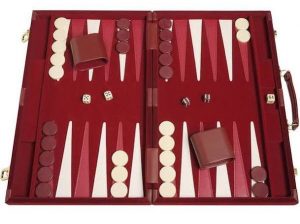 Perfectly serviceable backgammon sets that include all the essential equipment in a conveniently portable and very affordable solution can be had for $50 or even less. You can find many such sets at general department / toy stores, or online via Amazon, Walmart, and many other online distributors, as well as on the GammonVillage backgammon store.
Perfectly serviceable backgammon sets that include all the essential equipment in a conveniently portable and very affordable solution can be had for $50 or even less. You can find many such sets at general department / toy stores, or online via Amazon, Walmart, and many other online distributors, as well as on the GammonVillage backgammon store.
These sets typically have checkers in the 1″ – 1.25″ range, pitted dice, and oblong cups that lie in the playing field when closed, making for a thin and compact board frame you can take anywhere. Materials are generally of the ‘faux’ variety — leatherette points and exterior, simple modern plastic checkers. Perfectly adequate for learning the game and developing a backgammon habit!
19-Inch Silverman & Co ($140)
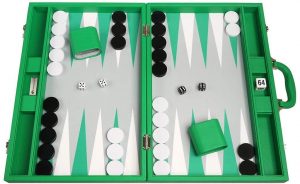 At the high end of the budget backgammon options is this medium-sized beauty. It’s 1.5″ checker size means you get a generous playing field where your dice can get a nice full rolling on the padded felt surface, but the case, measuring 19″ across, is more conveniently portable than “tournament size” sets with 1.75″ checkers. (They also offer smaller sets with 13″ or 16″ cases.) Available in a surprisingly wide variety of lively or sober colors, you can pick a style to suit your taste — and these sets are of a solid quality and elegance that they’re worthy of dressing up a bit further with precision dice and perhaps a fancier doubling cube!
At the high end of the budget backgammon options is this medium-sized beauty. It’s 1.5″ checker size means you get a generous playing field where your dice can get a nice full rolling on the padded felt surface, but the case, measuring 19″ across, is more conveniently portable than “tournament size” sets with 1.75″ checkers. (They also offer smaller sets with 13″ or 16″ cases.) Available in a surprisingly wide variety of lively or sober colors, you can pick a style to suit your taste — and these sets are of a solid quality and elegance that they’re worthy of dressing up a bit further with precision dice and perhaps a fancier doubling cube!
NEBC member Eric Packer is very happy with his handsome black and grey 19″ Silverman & Co set, conveniently purchased from the GammonVillage store on Amazon.com.
Crisloid ($200 - $450)
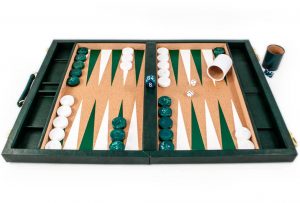 Crisloid boards, made in nearby Providence RI, have long been the workhorses of the backgammon world. Their durable cork surfaces, solid workmanship and reasonable prices have made them a popular favorite for decades. And given the usual proximity of dice and beer and other potables, there’s nothing like the easy-cleaning properties of cork when a hapless opponent dumps a glass of rioja across your board.
Crisloid boards, made in nearby Providence RI, have long been the workhorses of the backgammon world. Their durable cork surfaces, solid workmanship and reasonable prices have made them a popular favorite for decades. And given the usual proximity of dice and beer and other potables, there’s nothing like the easy-cleaning properties of cork when a hapless opponent dumps a glass of rioja across your board.
But Crisloid isn’t sitting back on their laurels. In the 2000’s they’ve responded to the advent of many new competitors with a wide range of new styles and custom options for playing surface designs, case materials, and checker colors. Visit their site to get a sense of what’s available! But at $200 for their baseline “Champion” set, it’s hard to go wrong. Anything you want to pay beyond that is all aesthetic gravy.
It’s worth mentioning that Crisloid provided the original hard-frame sets that NEBC used in the 1980’s-90’s when we used to store them at our Sheraton Commander location. Some of these sets are still kicking around in our midst, a reminder of a day when NEBC had a large enough following to provide boards for all comers!
But Crisloid also offers some exceedingly handsome table-top (non-folding) and full-furniture backgammon tables these days, well worth considing for your home gaming parlor.
Wycliffe Brothers ($275 - $400)
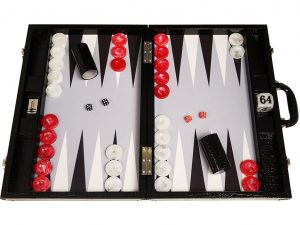 As the website points out, “The Wycliffe Brothers® Tournament Backgammon Sets combine the features normally found in top luxury sets with a price that anyone can afford.” This is certainly a valid claim, and the Wycliffe boards are a natural for players who want to step from inexpensive smaller sets to a “Tournament Size” board.
As the website points out, “The Wycliffe Brothers® Tournament Backgammon Sets combine the features normally found in top luxury sets with a price that anyone can afford.” This is certainly a valid claim, and the Wycliffe boards are a natural for players who want to step from inexpensive smaller sets to a “Tournament Size” board.
Wycliffe sets feature a smooth “V-Fiber™” playing surface developed in-house to provide a smooth but not too slippery surface for the checkers to glide across. Case and cup materials, though not luxury leathers, are very presentable, and the sets “play well.”
As an “affordable” set, though, the materials are not as robust as more pricey options, so Wycliffe sets will tend to wear down substantially after a few years of weekly play. If you are already a committed backgammon aficionado, you should probably save up for a more durable set — but if you’re still testing the waters, this may be just what you’re looking for!
Bone Club (£149.00 - £7000.00)
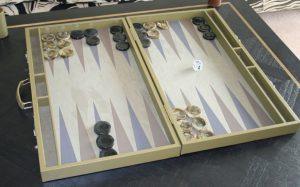 Bone Club of the UK brings an inventive, edgy sensibility to the often staid world of backgammon makers. Their entry-level “ready to play” boards are remarkably economical at current exchange rates and come in four distinctive and playfully-named models (the one at right is 7 Nation Army). Their standard checker size is the popular European 50mm (2″) variety, but the lightweight materials keep the sets under a sporty 12 lbs. From there, Bone Club can work with you on all manner of custom boards ranging from pop-art creations featuring your favorite album art to more traditional luxury table-top sets. If you’re curious, check out the Bone Club Facebook photo gallery.
Bone Club of the UK brings an inventive, edgy sensibility to the often staid world of backgammon makers. Their entry-level “ready to play” boards are remarkably economical at current exchange rates and come in four distinctive and playfully-named models (the one at right is 7 Nation Army). Their standard checker size is the popular European 50mm (2″) variety, but the lightweight materials keep the sets under a sporty 12 lbs. From there, Bone Club can work with you on all manner of custom boards ranging from pop-art creations featuring your favorite album art to more traditional luxury table-top sets. If you’re curious, check out the Bone Club Facebook photo gallery.
Gammon Tt - Gunduz Gunes ($300 - $450)
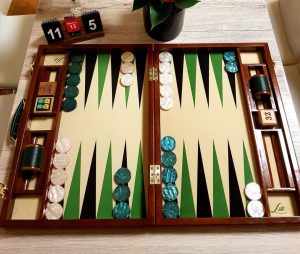 Gunduz Gunes runs a textile and furniture business in Turkey, but backgammon is his great passion. As a promoter of the game in clubs across Turkey, he has applied his professional expertise to the making of fine boards, often branding the cases, fields and checkers with club names or logos. Treating board-making as promotional activity and not a money-maker means that he prices his sets at just above his costs, making his sets an extraordinary value. Pictured is a wood frame board with a durable, easy-cleaning sewn cloth playing surface. Exterior is wood with faux-leather side panels. Field colors are completely up to you, and Gunduz will include your logo at no extra cost. Sets include scoreboard and carrying bag as well as the usual cups, dice and cube.
Gunduz Gunes runs a textile and furniture business in Turkey, but backgammon is his great passion. As a promoter of the game in clubs across Turkey, he has applied his professional expertise to the making of fine boards, often branding the cases, fields and checkers with club names or logos. Treating board-making as promotional activity and not a money-maker means that he prices his sets at just above his costs, making his sets an extraordinary value. Pictured is a wood frame board with a durable, easy-cleaning sewn cloth playing surface. Exterior is wood with faux-leather side panels. Field colors are completely up to you, and Gunduz will include your logo at no extra cost. Sets include scoreboard and carrying bag as well as the usual cups, dice and cube.
Gunduz Gunes does not have a commercial website devoted to his backgammon boards, but can be contacted via his Facebook Bursa Backgammon Club page.
Dal Negro ($300 - $500)
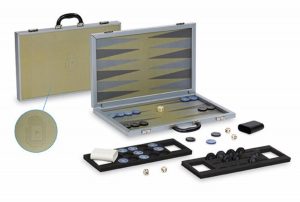 Centuries-old Italian games maker Dal Negro is a surprising newcomer to the modern backgammon scene. Adjusting to the current vogue for smooth-gliding surfaces rather than leather playing fields, they have made a change to a composite fiber more in line with competing sets. But they have retained some distinctive features that lend them a unique appeal. Most strikingly, they have bucked the trend of building a checker tray into the frame, opting instead for removable storage trays that hold and display the playing pieces, substantially reducing the overall size of the set for more convenient portability. Their checkers have a gleaming “mother of pearl effect” laser-etched with the company logo.
Centuries-old Italian games maker Dal Negro is a surprising newcomer to the modern backgammon scene. Adjusting to the current vogue for smooth-gliding surfaces rather than leather playing fields, they have made a change to a composite fiber more in line with competing sets. But they have retained some distinctive features that lend them a unique appeal. Most strikingly, they have bucked the trend of building a checker tray into the frame, opting instead for removable storage trays that hold and display the playing pieces, substantially reducing the overall size of the set for more convenient portability. Their checkers have a gleaming “mother of pearl effect” laser-etched with the company logo.
We hope to begin seeing Dal Negro sets at ABT events before long – they are a stylish addition to the field, and the price is right. They are available from GammonVillage as well as the Dal Negro site.
Erhan 869BG ($450 - $700)
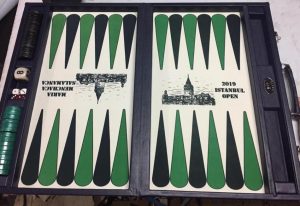 Erhan Doğrusöz has built a strong following for his handmade boards since he began crafting them in 2007. A competitive player himself (WBF Turkey Champion of 2013), he brings a player’s sense of the practical and sensuous qualities needed in a backgammon set.
Erhan Doğrusöz has built a strong following for his handmade boards since he began crafting them in 2007. A competitive player himself (WBF Turkey Champion of 2013), he brings a player’s sense of the practical and sensuous qualities needed in a backgammon set.
Rather than taking the high-luxury approach, Erhan aimed for a cost-effective combination of materials and processes in order to deliver a quality playing experience at an affordable price. The washable playing surface is a “rubber back flock material” that is resistant to stains from spilled drinks, and provides comfortable checker action and dice bouce. He has also taken a strictly custom-made approach, affording each buyer a wide range of color options and special features like custom logos or names to be applied to the playing surface. Erhan’s Facebook Photo Gallery will give a sense of the vast range of surface styles he can offer, from ultra-simple to highly elaborate.
Erhan’s boards have earned a happy following in his native Turkey, Europe, and the United States. His website includes enthusiastic testimonials from familiar international figures like Phil Simborg, Steve Sax, and fellow board-maker Taki Morioka. Phil Simborg is the US rep for the Erhan 869 boards, so you can order them conveniently via the BLC website.
Artgammon ($400-$1000+)
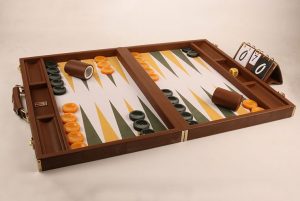 Artgammon is a Turkish company that offers a wide variety of custom board styles and color options. Their sets feature “a special synthetic sewn cloth chosen for durability, stain resistance and unmatched playing characteristics” and quality polyester checkers.
Artgammon is a Turkish company that offers a wide variety of custom board styles and color options. Their sets feature “a special synthetic sewn cloth chosen for durability, stain resistance and unmatched playing characteristics” and quality polyester checkers.
Prices are not provided on their website, perhaps because they are not set up for international online sales, but it appears that Gammon Guys are acting as distributors of their equipment for the American market.
Close inspection of some accessory pictures on the Artgammon site tend to support some reports of dissatisfaction with the finishing of some of their playing pieces. However, NEBC organizer David Kornwitz is happy with his handsome Artgammon set, won as a prize at the 2018 Connecticut ABT tournament.
Aries ($500 - $800)
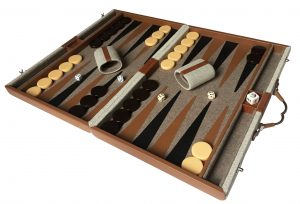 In the backgammon heyday of the 1970’s and 80’s, Casa Aries was the must-have luxury board. Falling on hard times in the 1990’s, the brand ceased production, but two decades later has been resuscitated for the contemporary scene.
In the backgammon heyday of the 1970’s and 80’s, Casa Aries was the must-have luxury board. Falling on hard times in the 1990’s, the brand ceased production, but two decades later has been resuscitated for the contemporary scene.
True to their history, the modern Aries sets are finely crafted, employing sensuous materials: leather exterior, woven cloth surface, finely-stitched leather points, pearlescent acrylic checkers, and gleaming brass and brushed nickel fittings. Aries boards also have a good reputation for durability.
Prices on the Aries website are in Mexican pesos, which from what I can tell means you divide by roughly 20 to get American dollars, leading to a price of $500+ for their premium sets. On GammonVillage you can find a selection of Aries boards for $675-$795.
Casa de Gamao ($500 - $600)
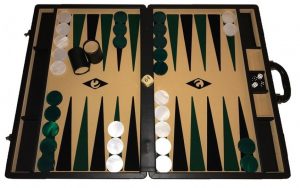 This Brazilian maker, whose brand translates to “House of Backgammon,” offers fine, luxurious sets with billiard-style felt playing surfaces, perfectly inlaid points, and solid leatherette cases. Checkers are available in ‘tournament’ sized 45mm and larger 50mm diameter options. One of the distinctive features of the Gamao boards is the stylish ‘floating’ point style, where the base of the triangles are set slightly apart from the frame, but its their disciplined color schemes that deliver consistent elegance: typically a neutral beige playing surface, with one bold accent color paired with black points. Classic.
This Brazilian maker, whose brand translates to “House of Backgammon,” offers fine, luxurious sets with billiard-style felt playing surfaces, perfectly inlaid points, and solid leatherette cases. Checkers are available in ‘tournament’ sized 45mm and larger 50mm diameter options. One of the distinctive features of the Gamao boards is the stylish ‘floating’ point style, where the base of the triangles are set slightly apart from the frame, but its their disciplined color schemes that deliver consistent elegance: typically a neutral beige playing surface, with one bold accent color paired with black points. Classic.
Carol Joy Cole represents Gamao for the US market. Ask Carol about the availability of a closely-tailored, zippered protective outer cover that comes included in the purchase price!
FM Gammon ($425 - $1200)
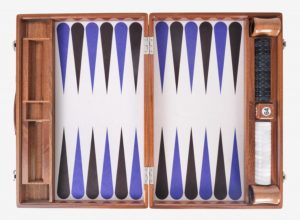 FM Gammon is a Turkish outfit whose quality products at competitive prices have been finding a growing audience in the American market. Their higher-end boards, as pictured here, boast solid wood frames at substantially lower cost than you would pay for similar custom boards by American makers. FM have also developed attractive, durable synthetic playing surfaces that can be very easily replaced without dismantling the board itself, as shown in this promotional video. You can experiment with your own color designs, including the option of including a personal logo or image for the playing field, with their Board Builder tool.
FM Gammon is a Turkish outfit whose quality products at competitive prices have been finding a growing audience in the American market. Their higher-end boards, as pictured here, boast solid wood frames at substantially lower cost than you would pay for similar custom boards by American makers. FM have also developed attractive, durable synthetic playing surfaces that can be very easily replaced without dismantling the board itself, as shown in this promotional video. You can experiment with your own color designs, including the option of including a personal logo or image for the playing field, with their Board Builder tool.
FM Gammon have also gained admiration for their fine crafting of the specially designed ‘Neptune’ and ‘Earth’ boards recently featured in the UBC ‘Mochy vs. Ueda’ tournament series hosted by backgammon Galaxy, and featured for sale on the galaxy website. You can also see many images of FM boards on their Facebook page.
FTH / Gammon Stuff ($800 - $1500)
 FTH boards have staked out an enviable space in the luxury backgammon board market by providing a sumptuous playing field composed of seamlessly inlaid (not stitched-on) points made of fine merino wool. The result is a long-wearing surface that does not fade and does not smudge . . . and is pure pleasure to play on. FTH sets are available in a wide variety of color options, and may be custom-branded with personalized logos or names on the game surface.
FTH boards have staked out an enviable space in the luxury backgammon board market by providing a sumptuous playing field composed of seamlessly inlaid (not stitched-on) points made of fine merino wool. The result is a long-wearing surface that does not fade and does not smudge . . . and is pure pleasure to play on. FTH sets are available in a wide variety of color options, and may be custom-branded with personalized logos or names on the game surface.
FTH boards and accessories are handmade by German craftsman Fazil Terlemez (FTH), and exclusively distributed for the US market by Gammon Stuff. USBGF board member and treasurer John Pirner, the founder and owner of Gammon Stuff, has promoted the rapid rise in popularity of FTH boards through frequent sponsorship of ABT events where a coveted FTH board branded with the tournament name is offered as a prize.
Local NEBC Champion Alex Zamanian is a happy owner of an FTH board if you’d like to see one up close.
Backgammon Galaxy ($900 - $1100)
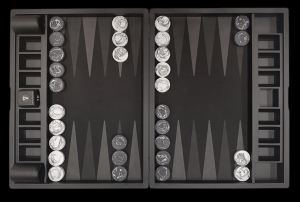 Backgammon Galaxy has revolutionized online backgammon with their highly polished playing site that melds PR performance with match results in its ratings system. But they have also moved boldly into the luxury board market, partnering with premium makers FM Gammon on a series of celestial-themed boards. The Earth Board comes in an inventive modular design that allows removable checker trays to be inverted and used as pedestals for clocks or scoreboards. The new Void Board, pictured here, comes in a monochromatic scheme that evokes the dark of space, with weighty matte checkers that might have fallen from the sky. If that’s too bleak, you can purchase extra “MagFit” inlays and checker sets in a variety of colors named for Earth, Jupiter, Nebula, Moon, and of course Galaxy’s familiar online blue “Neptune” color scheme. Galaxy sets are quite heavy, but come with very fine carrying bags if you want to take them on the road.
Backgammon Galaxy has revolutionized online backgammon with their highly polished playing site that melds PR performance with match results in its ratings system. But they have also moved boldly into the luxury board market, partnering with premium makers FM Gammon on a series of celestial-themed boards. The Earth Board comes in an inventive modular design that allows removable checker trays to be inverted and used as pedestals for clocks or scoreboards. The new Void Board, pictured here, comes in a monochromatic scheme that evokes the dark of space, with weighty matte checkers that might have fallen from the sky. If that’s too bleak, you can purchase extra “MagFit” inlays and checker sets in a variety of colors named for Earth, Jupiter, Nebula, Moon, and of course Galaxy’s familiar online blue “Neptune” color scheme. Galaxy sets are quite heavy, but come with very fine carrying bags if you want to take them on the road.
NEBC organizer Albert Steg has added both an Earth board and a Void board to his growing collection.
P-40 ($1000+)
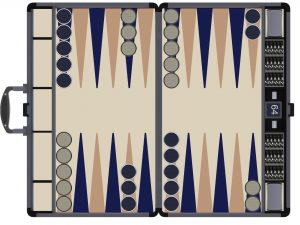 The P-40 board introduced a dramatic new approach to set-making. True to its military-style branding, the P-40 has the feel of a precision-manufactured armament. A metallic frame plays host to a pair of custom-crafted playing surfaces that can be customized for your aesthetic or branding needs. These boards slot neatly into the frame, locked down with a simple set of screws, and can be replaced any any time with new surfaces, whether because of wear, or because you crave a change in style. All of the color specifications, from frame to checker rims, can be custom-selected using the unique P-40 Board Builder.
The P-40 board introduced a dramatic new approach to set-making. True to its military-style branding, the P-40 has the feel of a precision-manufactured armament. A metallic frame plays host to a pair of custom-crafted playing surfaces that can be customized for your aesthetic or branding needs. These boards slot neatly into the frame, locked down with a simple set of screws, and can be replaced any any time with new surfaces, whether because of wear, or because you crave a change in style. All of the color specifications, from frame to checker rims, can be custom-selected using the unique P-40 Board Builder.
P-40 checkers boast metallic rims and textured surfaces similar in feel to the much more expensive Geoffrey Parker pieces, and the sharp clacking of metal checker on metal frame is part of the appeal of this set. The narrow dice cups have a small-bore military aesthetic, and lend a metallic rattle to your game, so make sure this is to your liking before committing to a purchase.
Albert Steg and Paul A. Caracciolo are NEBC regulars who own P-40 boards, so ask them for a test drive!
Tak Morioka ($1500)
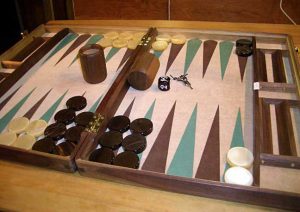 Chicago craftsman Tak Morioka picked up where Al Imm left of in the 1980’s, creating some of the most-admired wooden-frame sets on the backgammon scene. “Taki boards” are characterized by the solidity and elegance of their walnut or cherry frames and the pleasure of playing on their cotton velvet playing surfaces.
Chicago craftsman Tak Morioka picked up where Al Imm left of in the 1980’s, creating some of the most-admired wooden-frame sets on the backgammon scene. “Taki boards” are characterized by the solidity and elegance of their walnut or cherry frames and the pleasure of playing on their cotton velvet playing surfaces.
Tak has some examples of his work posted on his website (click image), so it’s a good idea to look at range of his productions and note the features you like best before contacting him to order a board of your own. Wood type, exterior fabrics, point styles, checker material and color, and of course the color scheme of the playing field are up to you. For an added bit of retro-style, note the attractive “dotted points” option on some of his sets hearkening back to a jazz-age board style.
While Taki boards are a pleasure to play on, the surfaces do tend to wear relatively quickly with frequent play, as the points are painted onto the fabric. You may note some gradual discoloration of the playing field, depending on the color combination you select. Tak does provide a re-surfacing option, though, so you can renew your set – even switching up your color scheme – if you like.
Gammoner ($1500 - $1850)
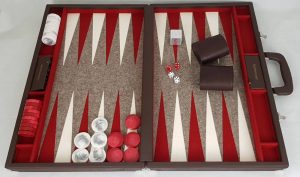 Gammoner boards are the creation of Volker Wenzlaff, who personally sources materials and crafts each board under this German luxury brand. The Gammoner website very clearly illustrates the many custom choices available to you when ordering your own personal masterpiece. The playing surface is Merino wool felt, with inlaid points, ensuring a smooth, color-permanent, and durable surface. The set is covered in South American Redena leather in a color of your choice. There are seven color choices available for their distinctly textured acrylic checkers.
Gammoner boards are the creation of Volker Wenzlaff, who personally sources materials and crafts each board under this German luxury brand. The Gammoner website very clearly illustrates the many custom choices available to you when ordering your own personal masterpiece. The playing surface is Merino wool felt, with inlaid points, ensuring a smooth, color-permanent, and durable surface. The set is covered in South American Redena leather in a color of your choice. There are seven color choices available for their distinctly textured acrylic checkers.
All the finer details of the set are marked by elegance and care, all vividly illustrated on the website. You can also visit the Gammoner Facebook page to see more pictures and comments on these fine boards. Jeff Proctor is the US representative for Gammoner, and you can contact him from either site.
Hector Saxe ($500 - $3700)
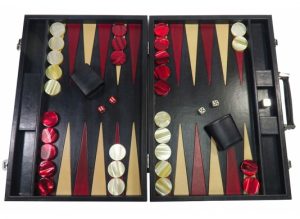 Hector Saxe boards come in such a wide variety of colors, materials, and prices that it is hard to convey their offerings in a brief summary. The magnificent “hand-patinated” leather set pictured here (3 360,00 €) is emblematic of the high-end luxury associated with the Parisian brand, though tournament players may tend to find that checkers do not slide effortlessly over the leather texture and inlaid points. But there are dozens of varieties illustrated on the Saxe website, and their more reasonably priced offerings, with printed felt surfaces and faux leather cases are very popular in Europe, though they have yet to make waves on the American side of the Atlantic. A couple dozen Hector Saxe sets are available on Gammon Village, while you should visit the Hector Saxe site itself (click picture at right) for the fullest range of options. While you’re there, make sure to check out the “Promotions” section, where they offer “tail end” inventory items at substantial discounts.
Hector Saxe boards come in such a wide variety of colors, materials, and prices that it is hard to convey their offerings in a brief summary. The magnificent “hand-patinated” leather set pictured here (3 360,00 €) is emblematic of the high-end luxury associated with the Parisian brand, though tournament players may tend to find that checkers do not slide effortlessly over the leather texture and inlaid points. But there are dozens of varieties illustrated on the Saxe website, and their more reasonably priced offerings, with printed felt surfaces and faux leather cases are very popular in Europe, though they have yet to make waves on the American side of the Atlantic. A couple dozen Hector Saxe sets are available on Gammon Village, while you should visit the Hector Saxe site itself (click picture at right) for the fullest range of options. While you’re there, make sure to check out the “Promotions” section, where they offer “tail end” inventory items at substantial discounts.
'Element' by Mustafa Sayid ($2000)
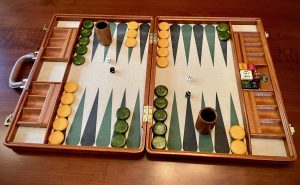
Mustafa Sayid has approached board construction in the tradition of Tak Morioka and Al Imm before him, crafting ‘bespoke’ boards to the precise specifications of his customers. Beautiful glossy wood finishes in cherry, mahogany, and maple, silkscreened points on a dense polyester field, and fine brass fittings combine with meticulous craftsmanship to beautiful effect. His dice cups are a pleasure too — light in the hand and gently musical to the ear.
Mustafa’s price includes board and cups only, and for a good reason: if you are having a custom set made, you should provide the checkers for the board to be built around. The size of your checkers will guide the craftsman’s measurements, and the color of the checkers should guide your choice of point and field colors. You should never design a board and then look for checkers to match. Mustafa encourages you to select an exterior case fabric from a commercial provider, or to send him fabric of your own choice. It is worth thinking carefully about how your outer fabric complements the playing surface colors.
NEBC Club Champions Marty Storer and Albert Steg own Element boards — Albert’s is pictured here, built around an unusual set of 1.6″ vintage bakelite checkers and chouette doubling cubes.
PRIMO ($2495 and up) *New*
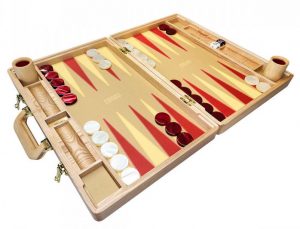 Founded in 2015 and formally known as Gamblicon, PRIMO prides itself on offering the highest quality workmanship and providing a luxury product made in the United States to rival anything available abroad. They offer ten handsome natural woods and 16 field styles in their online custom Board Builder, and have taken pains to design a playing surface with a neoprene pad underlying a polyacrylic coating that affords ideal dice action. Their lavishly illustrated website will tell you all you need to know about their fine materials and wide range of color and design options. If you are looking for a luxury wood frame set, PRIMO is surely one to consider.
Founded in 2015 and formally known as Gamblicon, PRIMO prides itself on offering the highest quality workmanship and providing a luxury product made in the United States to rival anything available abroad. They offer ten handsome natural woods and 16 field styles in their online custom Board Builder, and have taken pains to design a playing surface with a neoprene pad underlying a polyacrylic coating that affords ideal dice action. Their lavishly illustrated website will tell you all you need to know about their fine materials and wide range of color and design options. If you are looking for a luxury wood frame set, PRIMO is surely one to consider.
Geoffrey Parker ($2000 - $20,000+)
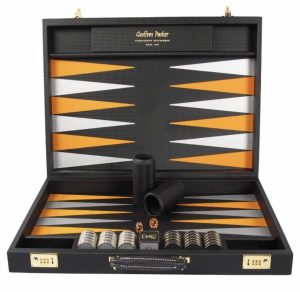 This venerable British luxury brand could be regarded as the Rolls Royce of backgammon. The bold leather surfaces and metal-rimmed checkers will be familiar to those who have attended the World Championships in Monte Carlo or other events where Geoffrey Parker has served as sponsor, such and the Texas Backgammon Championships in San Antonio.
This venerable British luxury brand could be regarded as the Rolls Royce of backgammon. The bold leather surfaces and metal-rimmed checkers will be familiar to those who have attended the World Championships in Monte Carlo or other events where Geoffrey Parker has served as sponsor, such and the Texas Backgammon Championships in San Antonio.
Parker boards come in a remarkable variety of configurations, playing surfaces, and checker styles, each customizable with an incredible array of choices for case, cup, field, and checker colors. Be sure to take note of the board dimensions and checker-sizes to ensure a comfortable playing experience, as some Parker boards are very large.
While the price is steep, the quality is unquestioned, and you will be purchasing an heirloom piece likely to survive generations.
Geoffrey Parker sets are handmade to order and require a 4-month crafting period. However, you can also purchase ready-made Parker sets under the ‘Excalibur’ re-brand on Gammon Village.
While we hope these comments, pictures and descriptions will be helpful in guiding your interest, NEBC is not explicitly endorsing any of these products, and has not received any benefit from listing them here. The best way to shop for a backgammon board — especially an expensive one — is to attend a major tournament (such as the Boston Open ABT event in February), where you will find examples of most of these boards in action.

